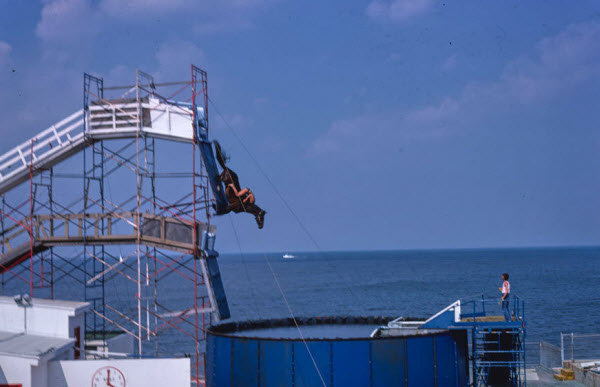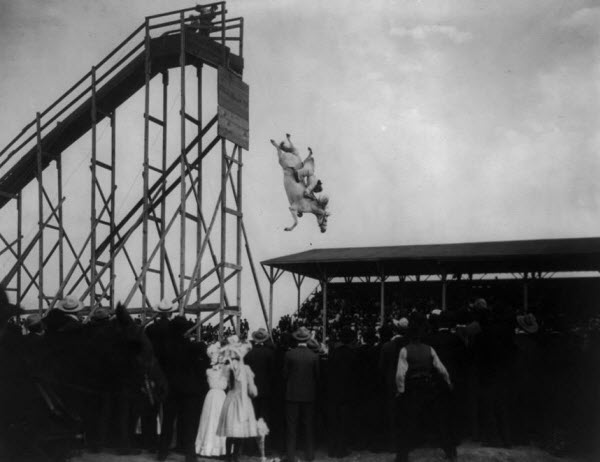“You can lead a horse to water, but you can’t make him drink”—this popular saying is well-known for its practical wisdom. However, some equestrians have defied this notion, not only leading their horses to water but also pushing them to take part in extreme adventures through the unique and bizarre sport of horse diving. This spectacle, which took place in the United States from the late 19th century until the 1970s, involved riders, often women in swimsuits, diving with their horses from towering wooden platforms, sometimes as high as 60 feet (18 meters)—twice the height of the highest Olympic diving boards—into a pool of water. It was a thrilling exhibition that captivated audiences for decades.

The Origins of Horse Diving
The sport of horse diving was created in the 1880s by an American named William Carver. The story goes that in 1881, Carver was crossing a bridge over the Platte River in Nebraska when it partially collapsed, sending both him and his horse into the water. This incident inspired him to train horses to dive, and he soon took his show on the road. The first public performance took place in 1894 in Kansas City, Missouri. Carver’s son, Al Floyd Carver, would build the diving towers, while his daughter, Lorena Carver, became the first rider to perform these daring stunts. In 1924, Sonora Webster joined the act, becoming the most famous horse diver in history. She performed two to six dives daily and eventually married Al Floyd Carver.

By 1928, horse diving had become a main attraction at the Steel Pier amusement park in Atlantic City, New Jersey. The park featured a variety of animal acts, including Rex the water-skiing dog, kangaroo boxing, dancing bears, elephants riding bicycles, and tightrope-walking cats. However, horse diving stood out as the most thrilling spectacle. Spectators would watch in awe as horses climbed a steep ramp to the top of the tower, then leaped into the water, headfirst, with their riders, swimming safely to the pool’s edge.



Controversy and Ethical Concerns
Despite its popularity, horse diving faced criticism, particularly from animal welfare organizations. Critics argued that the sport was cruel to the animals, believing that trainers used harsh methods like beating or electric shocks to force unwilling horses to dive. Horses, being naturally wild creatures, do not naturally take to diving, making the training process seem unnatural and unethical. Additionally, the horses performed these stunts up to four times a day during peak season, leading to concerns about their physical well-being. There were allegations that some horses suffered from internal injuries, broken bones, bruises, and damage to their legs and spines, claims that trainers and divers vehemently denied. They insisted that the horses were well-loved, enjoyed their work, and were treated like family. They also stated that no horse was forced to dive against its will, and there were no records of serious injuries to the horses. In fact, it was usually the riders who sustained injuries, with an average of two injuries per year. One of the most notable incidents involved Sonora Webster, who lost her sight due to a detached retina caused by a dive. Remarkably, she continued diving even after becoming blind, driven by her passion for the sport.

The End of an Era
As time passed and opposition from animal rights activists grew, the Steel Pier management eventually discontinued horse diving shows. Attempts to revive the sport in 1993 and 2012 were unsuccessful due to public backlash, marking the end of this unusual and controversial chapter in American sports history.
